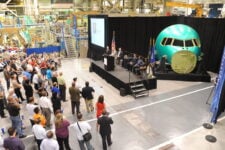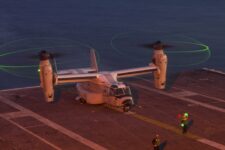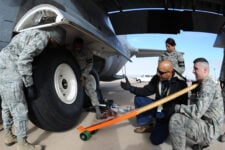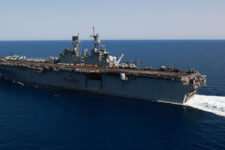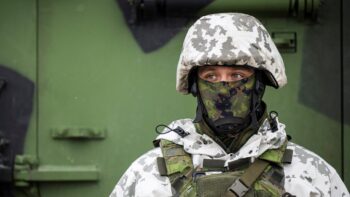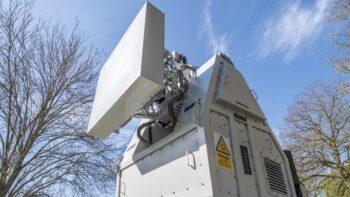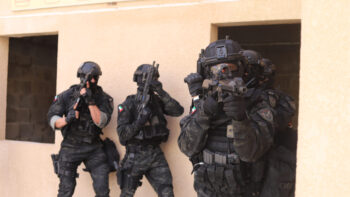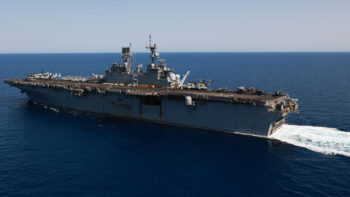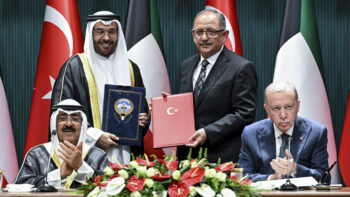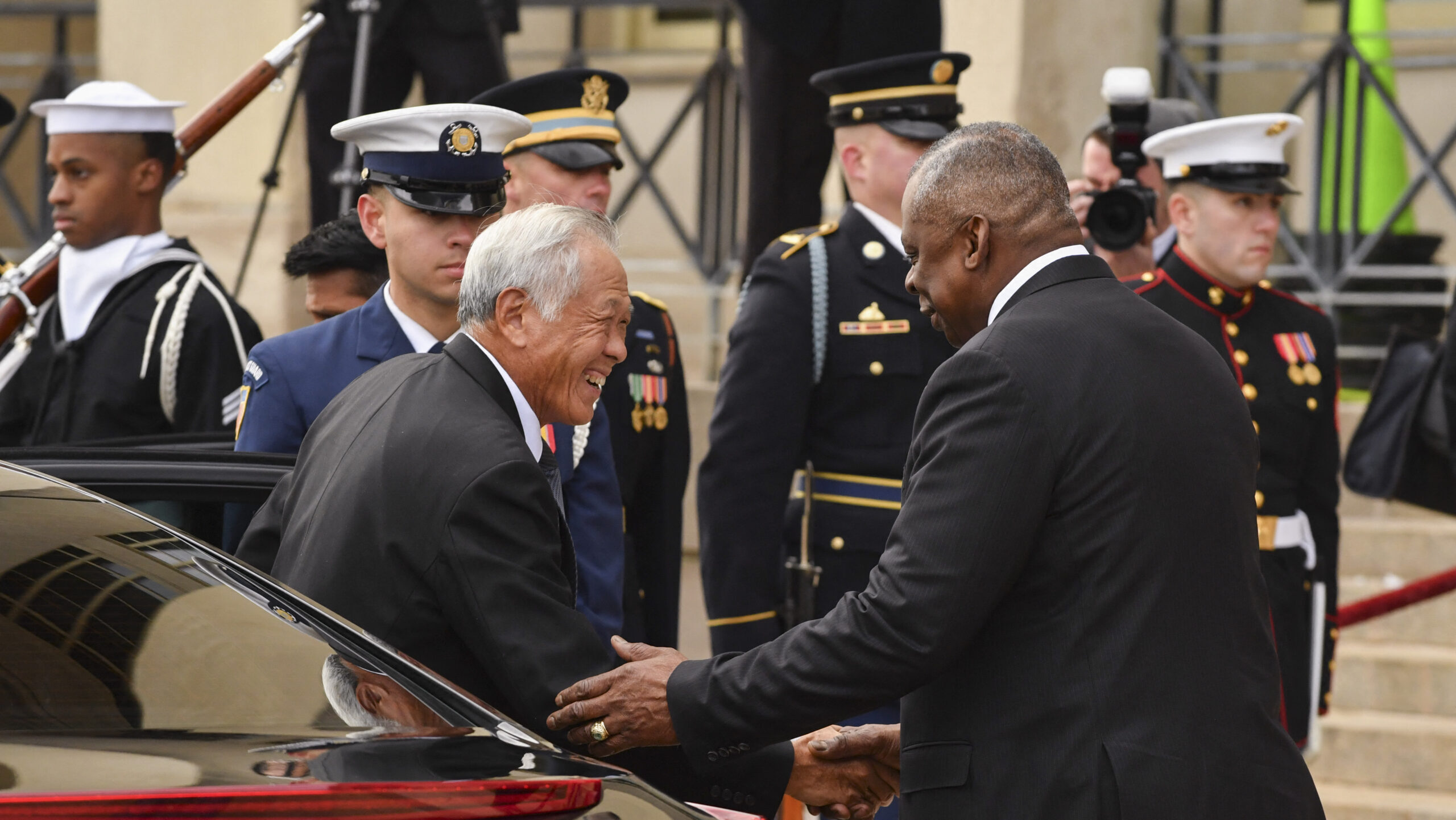
US Defense Secretary Lloyd Austin greets Singapore’s Minister of Defence Ng Eng Hen prior to a meeting at the Pentagon in Washington, DC, on December 6, 2023. (ROBERTO SCHMIDT/AFP via Getty Images)
SYDNEY — Sandwiched by Malaysia and Indonesia above and below, and with China lurking further north, the city-state of Singapore has always been cautious about the rhetoric it uses to define and defend itself, seeking to present a formidable defense without needlessly offending its much larger neighbors.
That is the essence of its latest military budget, but comes amid a realization that better defense is needed in an increasingly unstable world.
In a Feb. 28 tweet, Singapore Defense Minister Ng Eng Hen said he has “reversed my assessment for today’s generation in Singapore and elsewhere. The risk of regional and even global conflict in the next decade has become non-zero. I do not make this assessment lightly.”
On the face of it that might seem to be a tough critique of China’s actions in the South China Sea and against Taiwan, combined with a considered view of Russia’s illegal and brutal invasion of Ukraine. But, as Washington pundits often have it, budget is strategy and, by that measure, Singapore is beefing up some aspects of its military while largely keeping a steady course.
I have reversed my assessment for today’s generation in Singapore and elsewhere. The risk of regional and even global conflict in the next decade has become non-zero. I do not make this assessment lightly. #SGBudget2024
— Ng Eng Hen (@Ng_Eng_Hen) February 28, 2024
For instance, technically Singapore is boosting its defense spending substantially this year to S$15.4 billion ($11.5 billion USD), up 12.7 percent from S$13.6 billion ($10.1 billion USD) last year. It’s the first time since 1998 the ministry has seen double digit growth.
But it’s not a policy decision or a strategic decision, but rather a balancing out. The ministry spent roughly S$1.5 billion ($1.1 billion USD) or 10 percent less than planned in 2020 due to project delays of some projects, the minister told Parliament. COVID was responsible for most of those delays, he said.
“The average defense spending of Middle Eastern countries is about 4 percent of GDP. Europe is undergoing huge turmoil, and has not even spent 2 percent. But two decades ago, we were spending 5 percent of GDP on defence. Now, we are down to about 3 percent. That is a 40 percent reduction,” he said, according to a transcript of the speech. “This is even as total government spending as a percentage of GDP has increased, from an average of 16 percent in the early 2000s to an average of 18 percent in recent years.”
Collin Koh, a regional defense expert at the Institute of Defence and Strategic Studies of Singapore’s Nanyang Technological University, told Breaking Defense, “In no way are we looking at a significant shift in Singapore defense policy or spending.”
“Basically he is trying to say the direction is increasingly complex, but there is no reason to spend more overall,” Koh said. “This non-zero thing might be a new thing in the speech by the minister, but it doesn’t necessarily indicate a shift in Singapore defense policy.”
In fact, Koh points to Singapore’s Armed Forces 2040 roadmap for the country to show how important innovation and holding the line on spending are.
“Given the landscape of scarce and plateauing defence resources (manpower, fiscal and time), SAF leaders at all levels must endeavour to achieve stretched mission outcomes with limited or less resources, through resource optimisation and effective collaboration with non-defence/external stakeholders and partners,” the roadmap says. “Our creativity to innovate, and the effective engagement and motivation of our people will also provide levers and force multipliers within the SAF’s constraints to do more with less.”
In his address to parliament, the minister made much of the country’s decision to buy F-35As, putting it in a select group of countries that fly both the conventional fighter and the STOVL version, the F-35B. It will buy eight F-35A stealth jets, increasing its Joint Strike Fighter fleet to 20.
“When the F-35s are operational, we will be in the premier league,” the defense minister said in his speech. “The F-35A variant that I’m announcing today, if Parliament approves our budget, will arrive around 2030. We may have to deprioritise other projects for this opportunity buy, but we have done our calculations and we think that this is the best time to put in orders for the F-35As.”
Beyond the F-35 buy, Ng ticked off the small country’s other major programs, noting the fourth and final Invincible class submarine will launch this year. The Army will also bring its new Armored Tracked Carriers (ATC) and next-generation howitzers into service. “The new Howitzers are self-loading to shoot faster, and require 60 [percent] less manpower,” he said. That’s an important factor for Singapore, which faces declining manpower.
The Navy’s Unmanned Surface Vessel (USV) goes fully operational this year, Ng said.
“It will patrol the Singapore Strait alongside our Littoral Mission Vessels and patrol vessels. Locally designed and manufactured, these USVs are fully autonomous and can navigate our busy shipping lanes. It is a busy shipping strait and these are unmanned, but they were put to trials and they performed,” he said.


